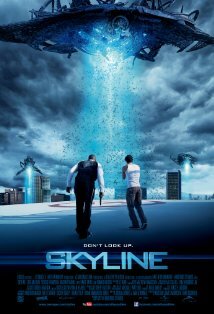Not long ago, it would cost Hollywood upwards of $100 million to destroy downtown Los Angeles, most of which would be spent employing an expert team of stuntmen, set designers, pyrotechnicians and a horde of visual artists. These days, it can be done at a fraction of the cost using a Mac Book Pro, a 3D modelling suite and many, many cans of Red Bull.
This new age of the ‘budget blockbuster’ is both a blessing and a curse. On one hand, it allows talented young filmmakers the opportunity to break out of the arthouse cinema and into the mainstream much easier and quicker. But on the other, it gives rise to the belief that anyone can make a blockbuster film so long as you know a thing or two about special effects. And that’s a scary thought.
Enter Skyline, the first of what I fear will be many apocalypse-on-a-shoestring films to bypass the Direct to DVD market and find its way into cinemas. And believe you me, if it wasn’t for the Hollywood-grade CGI effects, this woefully scripted, performed and directed feature from VFX artists Greg and Colin Strause wouldn’t have come close to being seen on the big screen.
The film begins when hung-over couple, Jarrod (Eric Balfour) and Elaine (Scottie Thompson), are awoken by a mysterious blue light shining through the blinds of their friend Terry’s (Donald Faison) luxurious LA apartment. They quickly discover that staring into the light causes complete transfixion, and much like a moth, the victims are uncontrollably drawn to it.
What’s the source of the light? Aliens, of course! And they want our brains…
If you’re looking for a deeper explanation than that, you’re not going to get it. The screenplay by Joshua Cordes and Liam O’Donnell is poorly constructed, introducing a number of plot points and character conflicts in the first act only to have them dropped the very moment the aliens arrive. From there, the drama stagnates to the point of nonexistence, allowing the film to show its true colours as a visual effects show reel. While it must be said that the quality and quantity of effects are impressive for such a low-budget affair – particularly considering that much of the action happens in broad daylight where the eye is more discerning of digital trickery – no amount of CGI can truthfully recreate the thrilling, unmistakable sense of danger that an in-camera stunt provides. Moreover, the Brothers Strause haven’t an eye for suspense, causing even the most visually arresting scenes to be met with nothing more than a yawn.
The performances are uniformly bland, but with characters this poorly-drawn, it’s hard to blame the actors. It’s astonishing how badly misdirected they are, often prone to bizarre, incongruent chunks of cheesy dialogue that clearly belongs to the mind of someone else. As playboy millionaire Terry, Donald Faison of Scrubs fame is the most entertaining of the bunch, breathing a bit of goofy energy into a screenplay that takes itself far too seriously given its B-movie vibe. The film would have been wise to incorporate a sense of humour, perhaps even a hint of genre satire given how willing it is to lift concepts straight from the likes of Invasion of the Body Snatchers, War of the Worlds, Independence Day, Cloverfield and District 9. The Brothers Strause don’t pay homage to these films, they blatantly plagiarise them.
Ultimately, Skyline is a good example of what can visually be achieved on a tight budget, but it’s an even better example of why filmmaking should be left to filmmakers.
 Follow the author Anders Wotzke on Twitter.
Follow the author Anders Wotzke on Twitter.


![2010_skyline_001[1] 2010 skyline 0011 e1289550694181 700x299 Skyline (Review)](/wp-content/uploads/2010_skyline_0011-e1289550694181-700x299.jpg)

 The Darkest Hour (Review)
The Darkest Hour (Review)









